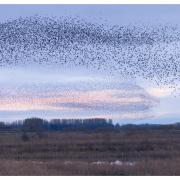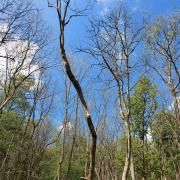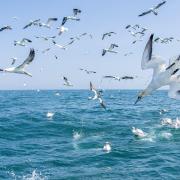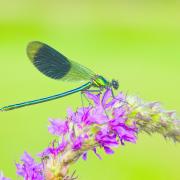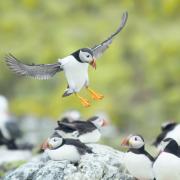Clea Grady from the Yorkshire Wildlife Trust (YWT) examines the link between the natural world and our mental and physical health, and provides some ‘quick wins’ for hitting your daily steps target while keeping it wild.

After the excitement and excess of December, it’s common to feel low and a little overwhelmed by the bleak winter months ahead. Our typical Christmas indulgences only add to this mood of lethargy and it’s easy to stay indoors and forget that getting out and about will not only lift your spirits but make you feel healthier altogether.
Seasonal affective disorder (also known as ‘winter depression’) tends to be more severe during these harsher months, but researchers at Harvard Medical School have found that simply spending time in nature can significantly impact our mental outlook. Couple this with the well-documented benefits of exercise (reducing stress and increasing ‘feel good’ hormones like dopamine), and going for a wild walk is an all-round win/win. In order to feel better mentally and physically, we need to be doing exactly the opposite of what we traditionally do at this time of year… embrace the great outdoors!
Helpfully, fitness trackers like Fitbits are likely to have found their way into Christmas stockings up and down the region. These track daily activity, including our steps, active minutes, stationary time and calories burned, and come set to a 10,000 daily step target. 10,000 steps equates to about eight kilometres for most people but incorporating this into everyday life can feel daunting.

With our increasingly sedentary lives and hours spent behind the wheel or in front of computer screens, walking for roughly two hours a day may seem like a lot. However, an additional perk of nature walking is that it’s easy to forget how much exercise you’re actually doing. Distracted by the beauty around you, you’ll accumulate a good proportion of your daily steps without even realising it, and even more so if you’re keeping your eyes peeled for wildlife. What’s more, if you don’t own a fitness tracker then you can feel confident about achieving a significant chunk of exercise if you walk around an already mapped-out nature reserve.
Winter is a lovely time to be outdoors – especially in Yorkshire. As long as you’re dressed for success, then the cold air is no barrier. In fact, winter walks are more invigorating than summer dawdles and there’s also the promise of a warming cuppa and a fireplace at the end. Plus you won’t be the only one venturing forth, for there is a huge array of wildlife out there.
The Yorkshire Wildlife Trust’s Potteric Carr reserve is renowned for wetland birds and bitterns can be found stalking the whispering reeds of at this time of year. A rare and shy heron, the bittern’s wonderfully camouflaged plumage blends perfectly into the lake reedbeds. Explore the habitats and magnificent vistas of this reserve and accrue your 10,000 steps by walking just a portion of the path network (11 kilometres in total). Not far from Doncaster, this wildlife haven is an easy escape from city life and also happens to be a favourite haunt of another beautiful bird; the marsh harrier. The largest of the harriers, you can identify marsh harriers by the distinctive V-shape they create in the air by holding their wings up. So be sure to look up when you’re walking around as well.

And for the chance to see more birds of prey, YWT Wheldrake Ings and is a superb place to see peregrine falcons, as well as marsh harriers. Not far from York, this reserve is also home to thousands of wintering wildfowl. The walk from the car park to the viewing hide and back is approximately 6,000 steps, so you’ll notch up a good percentage of your daily target just strolling around. The peregrine is the UK’s biggest falcon. It has a dark grey back and outer wings, a white belly that’s crossed with little black bars, and a black moustache and mask that’s set against its white throat and cheeks.
Getting out in nature is especially important for those of us who dwell in cities. Research shows that people living in urban landscapes experience ‘sensory overload’, which results in cognitive fatigue or a general feeling of mental exhaustion. Green space gives the brain a break from our fast-paced world and that’s why it’s not uncommon for people to experience mental breakthroughs or think up bright ideas when they’re active outside.
The charity MIND has much to say on how our mental and physical health are closely linked, and late last year The Wildlife Trusts published a report examining the positive effects of volunteering in nature. The results of this research, which was carried out by the University of Essex, showed that the mental wellbeing of more than two-thirds of the volunteers had improved within just six weeks of working outdoors.
And what could be more spirit-lifting than a bracing walk around the Yorkshire coast? Awesome in the truest sense of the word, the coastal path from South to North Landing at Flamborough Head is almost exactly 10,000 steps. An invigorating cliff top walk, it will blow away the cobwebs and captivate you with its breathtaking views and ever-changing seascapes.
In spring, these cliffs transform into one of the most important seabird colonies in Europe and are the best place in mainland Britain to see one of the world’s favourite birds: the puffin. Unmistakable in appearance, puffins look like they’re sporting smart little dinner jackets, which is somewhat at odds with their brightly coloured bills and orange legs and feet. For most of the year, these affable little clowns live out at sea but they like to return to land to breed, and Yorkshire’s 100 foot high sheer chalk cliffs make the perfect nesting spot.
In contrast to nesting birds, human bodies were designed to be active all day long. Unfortunately, that’s just not logistically possible for most of us in this day in age. It is conceivable, however, to make up for lost hours on our days off and there’s possibly no better place in the region for clocking up the winter miles than iconic YWT Spurn.
Internationally renowned for bird migration, this nature reserve is a wildlife-rich patchwork of beach, mudflats, saltmarsh, dunes, grassland, open water, saline lagoons and native sea blackthorn scrub. Walk from the Blue Bell to Spurn Point and back again and you’ll amass an impressive 16,500 steps. If this weren’t enough, you’ve also got a great chance of seeing grey seals as they feed and play near the peninsula. They’re often so close to shore that you can see them without binoculars, so take the time to stand, look out from the beach and take it all in. In fact, there may be no better way to beat the winter blues than this.
More tips for walking wild:
YWT Staveley Nature Reserve: 6,650 steps and a chance to see otters, red kites and roe deer
YWT North Cave Wetlands: 3,724 steps alongside teal, wigeon and tufted ducks
YWT North Cliffe Wood: for woodpeckers, 2,460 steps and bluebells in the springtime
YWT Garbutt Wood: 4,655 steps in the company of sparrowhawks and bullfinches
For directions to all Yorkshire Wildlife Trust nature reserves visit ywt.org.uk














